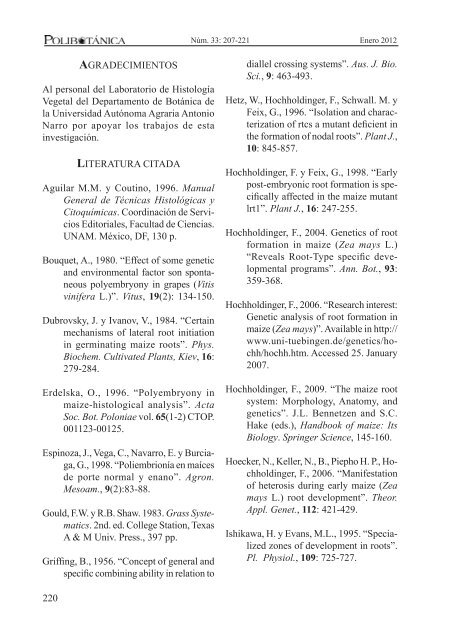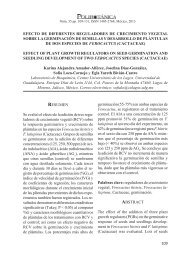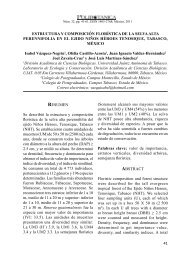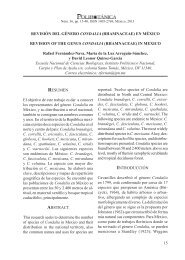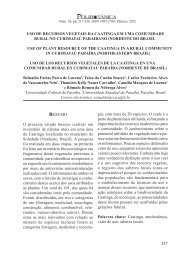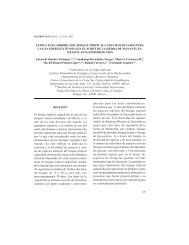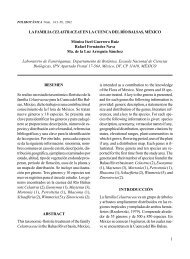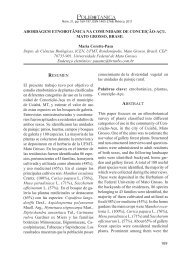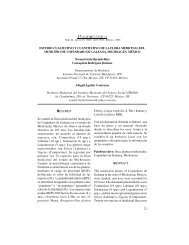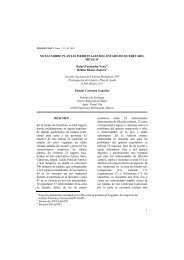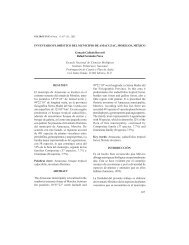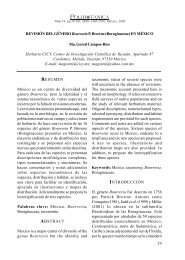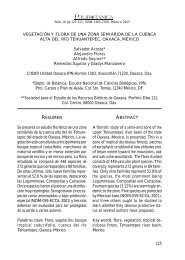versión extensa PDF (577 Kb)
versión extensa PDF (577 Kb)
versión extensa PDF (577 Kb)
Create successful ePaper yourself
Turn your PDF publications into a flip-book with our unique Google optimized e-Paper software.
220<br />
AGRADECIMIENTOS<br />
Al personal del Laboratorio de Histología<br />
Vegetal del Departamento de Botánica de<br />
la Universidad Autónoma Agraria Antonio<br />
Narro por apoyar los trabajos de esta<br />
investigación.<br />
LITERATURA CITADA<br />
Aguilar M.M. y Coutino, 1996. Manual<br />
General de Técnicas Histológicas y<br />
Citoquímicas. Coordinación de Servicios<br />
Editoriales, Facultad de Ciencias.<br />
UNAM. México, DF, 130 p.<br />
Bouquet, A., 1980. “Effect of some genetic<br />
and environmental factor son spontaneous<br />
polyembryony in grapes (Vitis<br />
vinifera L.)”. Vitus, 19(2): 134-150.<br />
Dubrovsky, J. y Ivanov, V., 1984. “Certain<br />
mechanisms of lateral root initiation<br />
in germinating maize roots”. Phys.<br />
Biochem. Cultivated Plants, Kiev, 16:<br />
279-284.<br />
Erdelska, O., 1996. “Polyembryony in<br />
maize-histological analysis”. Acta<br />
Soc. Bot. Poloniae vol. 65(1-2) CTOP.<br />
001123-00125.<br />
Espinoza, J., Vega, C., Navarro, E. y Burciaga,<br />
G., 1998. “Poliembrionía en maíces<br />
de porte normal y enano”. Agron.<br />
Mesoam., 9(2):83-88.<br />
Gould, F.W. y R.B. Shaw. 1983. Grass Systematics.<br />
2nd. ed. College Station, Texas<br />
A & M Univ. Press., 397 pp.<br />
Griffi ng, B., 1956. “Concept of general and<br />
specifi c combining ability in relation to<br />
Núm. 33: 207-221<br />
Enero 2012<br />
diallel crossing systems”. Aus. J. Bio.<br />
Sci., 9: 463-493.<br />
Hetz, W., Hochholdinger, F., Schwall. M. y<br />
Feix, G., 1996. “Isolation and characterization<br />
of rtcs a mutant defi cient in<br />
the formation of nodal roots”. Plant J.,<br />
10: 845-857.<br />
Hochholdinger, F. y Feix, G., 1998. “Early<br />
post-embryonic root formation is specifi<br />
cally affected in the maize mutant<br />
lrt1”. Plant J., 16: 247-255.<br />
Hochholdinger, F., 2004. Genetics of root<br />
formation in maize (Zea mays L.)<br />
“Reveals Root-Type specifi c developmental<br />
programs”. Ann. Bot., 93:<br />
359-368.<br />
Hochholdinger, F., 2006. “Research interest:<br />
Genetic analysis of root formation in<br />
maize (Zea mays)”. Available in http://<br />
www.uni-tuebingen.de/genetics/hochh/hochh.htm.<br />
Accessed 25. January<br />
2007.<br />
Hochholdinger, F., 2009. “The maize root<br />
system: Morphology, Anatomy, and<br />
genetics”. J.L. Bennetzen and S.C.<br />
Hake (eds.), Handbook of maize: Its<br />
Biology. Springer Science, 145-160.<br />
Hoecker, N., Keller, N., B., Piepho H. P., Hochholdinger,<br />
F., 2006. “Manifestation<br />
of heterosis during early maize (Zea<br />
mays L.) root development”. Theor.<br />
Appl. Genet., 112: 421-429.<br />
Ishikawa, H. y Evans, M.L., 1995. “Specialized<br />
zones of development in roots”.<br />
Pl. Physiol., 109: 725-727.


